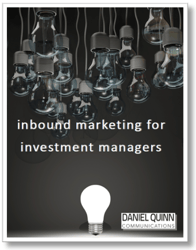 Does Inbound Marketing work for money management firms?
Does Inbound Marketing work for money management firms?
Yes.
But like most worthwhile business initiatives, Inbound Marketing for money managers requires planning, testing, and continual re-evaluation and refinement.
There are a few steps money managers can take to ensure their new Inbound Marketing strategy gets off on the right foot:
Nail Your Buyer Personas.
Buyer Personas are semi-fictional representations of a money manager’s ideal client. They are based on market research and real data about their existing customers. When creating buyer personas, consider including customer demographics, behavior patterns, motivations, and goals.
Buyer personas are perhaps the most important component of crafting an effective Inbound Marketing strategy for money managers. Why? Because they guide the entire content creation and distribution effort, which is one of the most important determinants of the answer to the question: does Inbound Marketing work for money managers?
For example, if a money manager’s clients and prospects don’t like reading long, detailed letters about a firm's take on the market, then don’t write long, detailed letters about the market. Write shorter blog posts on the issues that matter most to them – usually their investment portfolio, performance, and portfolio management. Professional insights are important, just be sure to apply them in ways that are meaningful to the target audience.
In terms of distribution, if few of a money management firm’s clients are using Twitter, while all use email and most use Facebook, then the content distribution strategy should center primarily on email and Facebook.
It seems obvious, but one of the most common errors firms make is to post their content where "everyone says they should," rather than focusing on where their target audience lives online.
Create useful, actionable content.
I referenced this above, but the reason why most content marketing efforts fail (other than poor follow-through), is because the money manager is writing content that is not centered on the issues and concerns of their clients; rather, money managers write about the things they think their clients and prospects should know, rather than what they actually want to know. Sometimes, these are the same, but they are often different.
So, how do you know what sorts of content would interest them?
Ask.
As part of the initial “getting-to-know-you” process, ask about their interests, what concerns them, what keeps them up at night? Then use those insights to craft content that they will find useful. And even if this particular prospect does not choose to do business with a firm, the manager has been able to gain valuable (and actionable) marketing intelligence as a result of the process.
Place Calls-to-Action (CTAs) on every page of the website.
A call-to-action is a button or link that enables a visitor to a money manager’s website to navigate to a form in which they provide their contact information in exchange for more information about a firm, download a piece of their thought leadership, subscribe to a blog, or respond to some other offer.
This is another of the linchpins of Inbound Marketing for money managers: it is what enables a money management firm to grow its contacts list, and begin converting website visitors into leads.
It lets money managers know who a visitor is, in what sorts of content are they interested, and how can they be reached?
Measure, Refine, Adapt.
But absent website visitors clicking on CTAs and filling out forms, money managers can use a paid Inbound Marketing service, like HubSpot, or free tools from Google Analytics and MailChimp to measure the effectiveness of both the message and the distribution. Take a look at metrics such as:
- Email opens & clicks (is your content, headlines, and subject lines drawing interest?).
- Page /website traffic, including organic search traffic (are visitors finding you as a result of a Google or other search engine search?).
- Conversion rates (how many people visit a page vs. how many visit AND fill out a form).
- Page performance (what pages on the site are most popular? Performance metrics offer important insights into the topics and content in which your audience is TRULY interested).
- Bounce rate (how many visitors land on one page, then immediately leave your site?).
- Time spent on each page (it is a measurement of how engaged your visitors are with your content).
And based on the results, a money manager can choose to offer more of one type of content, less of another, change their distribution network, or revise their entire Inbound approach from top to bottom. As they say, data don't lie.
Obviously, this is not an exhaustive list. If you are interested in additional information, DQCOMM has 3 complimentary eBooks on Inbound Marketing and digital content marketing for investment managers.


